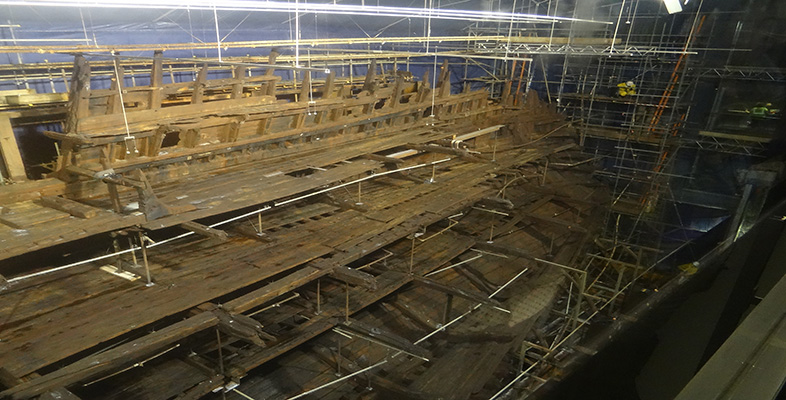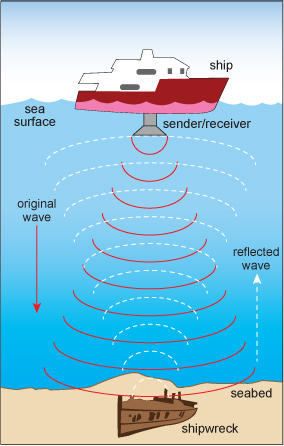2.1 Sonar and shipwrecks
Submarines use sonar to detect other nearby vessels, and dolphins and bats use sonar as their primary navigational device. When used in archaeology, sonar works by emitting a pulse of sound (a ping), which is reflected (echoed) back by a solid object (Figure 1). The seabed may reflect the ping to some extent, but solid objects, such as buried shipwrecks, cause major reflections. Echoes are detected and the location and depth of objects pinpointed. Since the 1960s, sonar surveys have located a huge number of buried objects at sea.
The two types of sonar that are most commonly used for underwater archaeology are side-scan sonar and multi-beam sonar. Side-scan sonar consists of an emitter towed by a ship, which emits two pulses of sound from either end. Multi-beam sonar emits several pulses from a collection of emitters distributed across the hull of a ship. Side-scan sonar consists of a single detector on the towed instrument, but multi-beam sonar uses several detectors placed across the hull of the ship. This means that multi-beam sonar can collect more echoes and provide much greater detail than side-scan. Both side-scan and multi-beam surveys generate data that is digitally converted into images.
The differences between the resolution of these two types of survey are illustrated in Figure 2. This figure shows a multi-beam sonar image of the site where the Mary Rose had once occupied the seabed. The deep purple colour at the centre of the image represents the dip left in the seabed after the ship was removed.
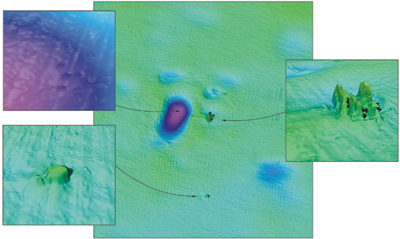
Figure 3 shows another timber ship, HMS Impregnable, which sank in the English Channel in 1799. This image was obtained using a side-scan survey, and when compared with Figure 2 shows the difference in resolution that can be obtained by multi-beam sonar. (Note that not all of HMS Impregnable is preserved on the seabed.)
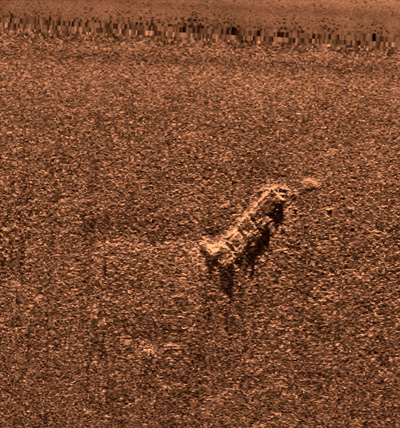
Inevitably, the best targets for sonar survey are ships or other objects made from metal, which are strong reflectors of sound waves, although ships constructed from timber are more often than not the most common targets sought. Figure 4 shows how a side-scan survey is improved if the target is made of metal rather than timber, thus giving a stronger reflected signal. Figure 4 is of the Lidador, a former trans-Atlantic steamship, which sank in the Azores during bad weather in 1878.
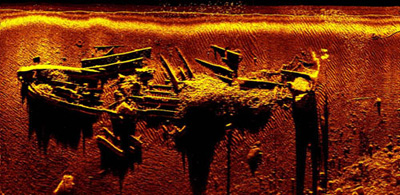
Side-scan and multi-beam surveys can be combined: Figure 5 shows a combined digital image generated by such a survey, which includes information about the wreck itself (HMS A1, the first submarine commissioned for the Royal Navy) and the seabed itself. Only part of the submarine has been preserved on the seabed.
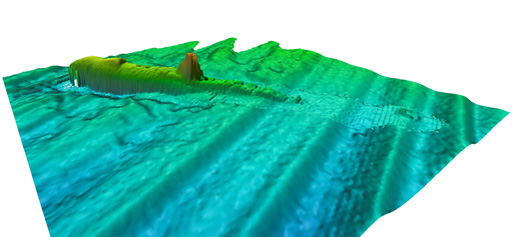
Sonar surveys are often combined with other instruments, such as magnetometers, which detect differences in magnetic properties, for example due to the presence of metal.
Sonar surveys of the Solent discovered the presence of a large buried object near to the alleged wreckage site, resulting in a concentrated investigation in that area. Divers confirmed, through the retrieval of artefacts, that part of the Mary Rose was preserved at only 11 m below low tide. (Further information about the artefacts found with the Mary Rose is given in Box 1.) This discovery led to huge publicity and an influx of financial support for the underwater excavation and salvage. On 11 October 1982, after 437 years underwater, the Mary Rose was carefully raised from the seabed by a hoist and cradle.
Box 1 The Mary Rose artefacts
Before raising the Mary Rose, 28 000 dives were made to investigate the wreck and retrieve artefacts and human remains. These items provided a wealth of information about life on board, and opportunities for scientific analysis.
Many of the artefacts appeared to have been personal possessions of the crewmen: dice, backgammon, inkwells and quills, clothing and shoes, fiddles and bows, and pipes. Navigational callipers, protractors and tide calculators were found in one cabin, which was assumed to belong to the ship's navigator. Similarly, a cabin full of surgical tools was thought to belong to the ship's barber-surgeon, who looked after the well-being of the crew. There, a long copper syringe was found that was thought to be used to treat gonorrhoea, which was prevalent at the time, by injecting mercury into the urinary tract as a disinfectant.
A wooden chest was found in the barber-surgeon's cabin, which contained bottles and jars full of what today would be called pharmaceuticals; other bottles were found scattered around the same cabin. Although there are historical reports of Tudor medicines, direct sampling is rare. The fragility of these containers meant that care had to be taken to sample their contents, but without their analysis the nature of these pharmaceuticals would remain unknown.
The contents of the bottles and jars were analysed using a technique called Raman spectroscopy (Edwards et al., 2004). Unfortunately, because of the influx of silt and mud over hundreds of years, the results from these analyses were inconclusive and largely represented only the seabed material, rather than the medicinal products.
